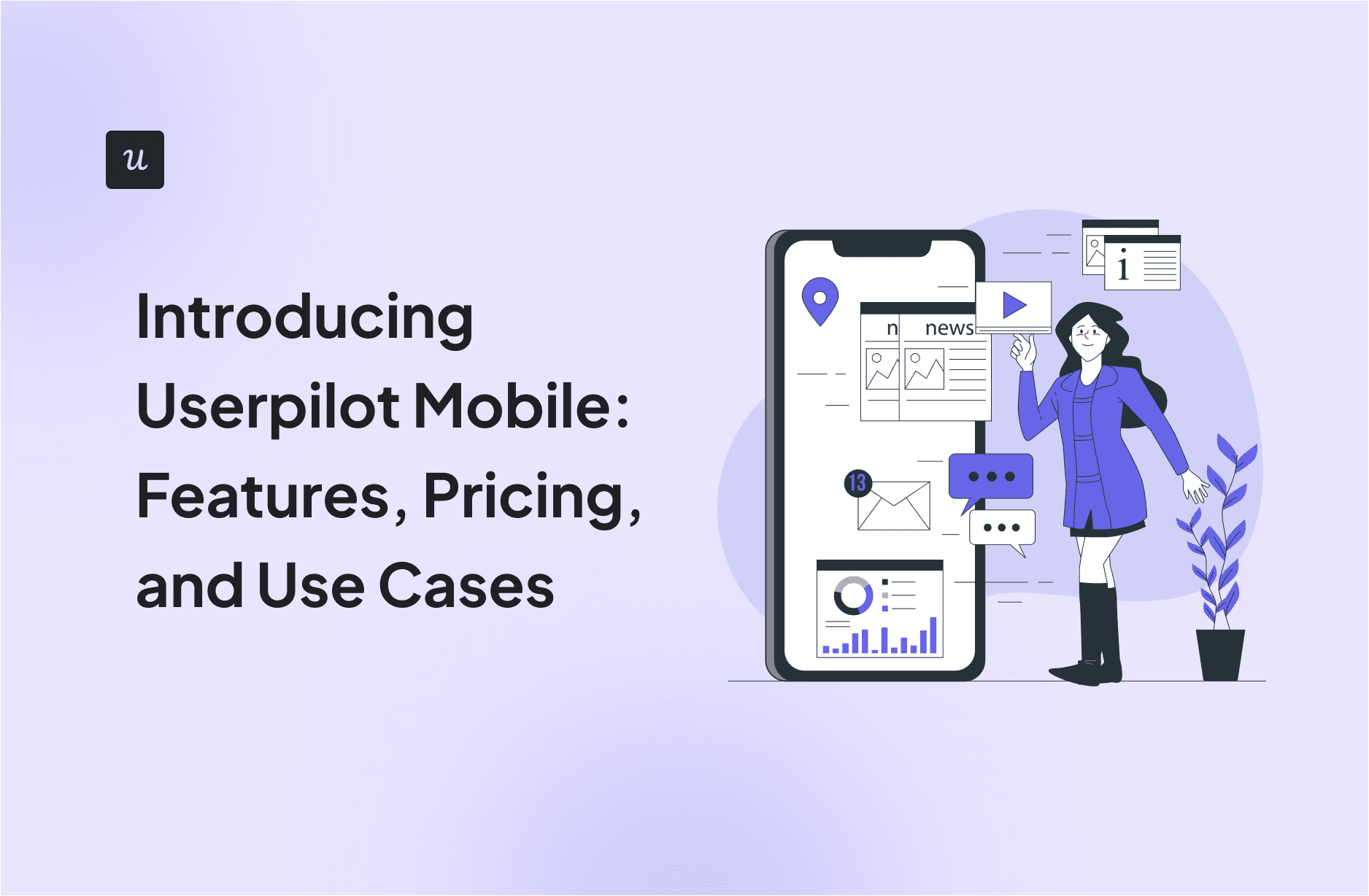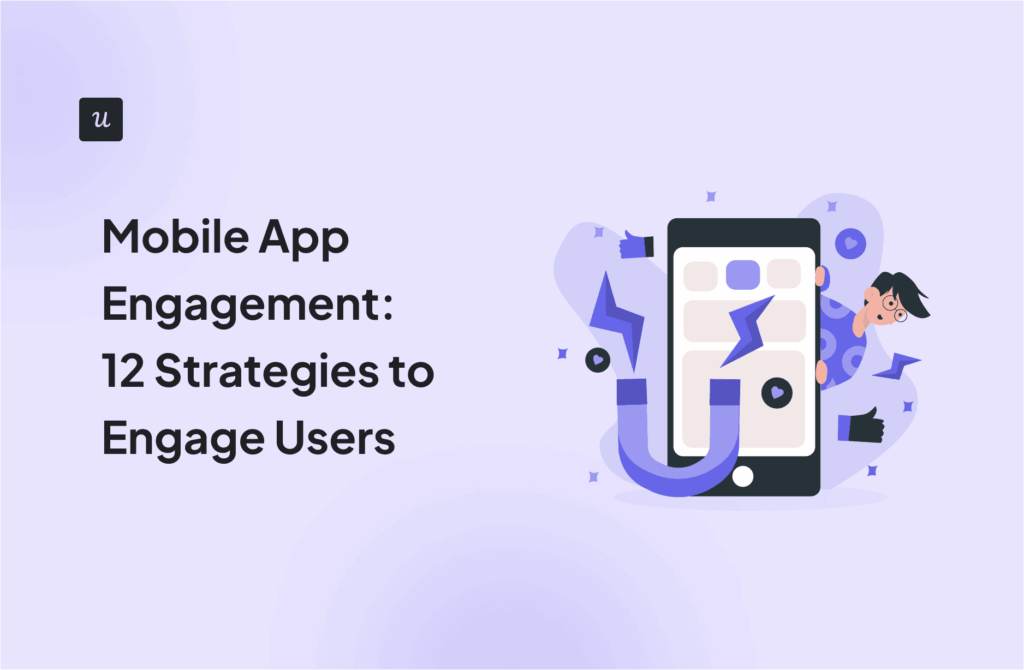
You’ve seen great success with your product and want to turn it into a mobile app. But when you try to build it, you realize it’s way harder than it looks.
As a product manager, I’ve seen it become a constant loop of juggling SDKs, waiting on engineering sprints, patching together feedback tools, and praying your analytics make sense. Even simple tweaks, like updating a tooltip or pushing a reminder, can take weeks. Meanwhile, your users churn because they find the app confusing.
Your product team deserves better. Not another tool you have to duct tape into your stack, but one platform to build, test, and improve mobile experiences.
That’s why we built Userpilot Mobile.
Try Userpilot Now
See Why 1,000+ Teams Choose Userpilot

What is Userpilot Mobile?
Userpilot Mobile is a no-code mobile onboarding platform that lets product teams build in-app experiences for mobile apps without waiting on dev support. As part of the broader Userpilot platform, it helps you guide, engage, and learn from mobile users at every stage of their journey.

With the SDK, you can trigger onboarding flows, tooltips, checklists, and surveys based on user events and properties. Want to show a specific experience only to users on iOS 17 who haven’t completed onboarding and speak Spanish? With Userpilot, you can.
Plus, instead of juggling separate platforms for onboarding, feature adoption, and user feedback, you can manage everything in one place. It connects to tools like Segment, Amplitude, or Mixpanel. Userpilot doesn’t just show you what users are doing. It helps you act on it in real time.
Why it matters: Market shift toward unified platforms
Product teams are tired of handling multiple tools just to create a smooth mobile experience. Using separate platforms for onboarding, feedback, and analytics creates silos, slower execution, and unnecessary complexity.
The market is shifting toward unified platforms that let teams manage everything from a single interface.
Userpilot Mobile is built for this shift.
It combines onboarding, surveys, tooltips, and user insights in one SDK, so teams can run the entire user journey without tool-switching.
5 Key Benefits of Userpilot for Mobile Teams
Now that you know what Userpilot Mobile is, let’s see how it can be the perfect partner for your mobile team:
1. Unified platform for web and mobile engagement:
Managing mobile and web onboarding separately creates fragmented experiences. With Userpilot, you get one platform to design, launch, and analyze in-app experiences across devices. This gives product teams a single source of truth to monitor behavior and drive growth, regardless of whether users log in on desktop or mobile.
2. No-code setup for fast deployment:
Shipping product tours or checklists shouldn’t be gated by engineering delays. With Userpilot’s SDK, product teams can push updates instantly. That speed turns onboarding experiments from quarterly projects into weekly habits.
3. Mobile-specific UI components:
User retention drops from 25.3% to 5.7% in the first 30 days. A major reason could be confusing onboarding. Userpilot helps you create product bumpers to get users on the right path. This includes mobile-specific elements like slideouts, carousels, and tooltips. It helps you deliver onboarding that feels native and actually engages your users. This subtle design advantage makes a measurable difference in activation rates.
4. Real-time analytics and in-app feedback:
Without real-time context, analytics just tell you what happened, not why. Userpilot closes the loop by pairing behavior tracking with in-app surveys. This lets you spot friction points, capture feedback at the moment of confusion, and fix problems to prevent churn.
If you’re still unsure how to set up mobile analytics for your app, I suggest watching this event by Posthog, a product analytics platform built for dev teams: From 0 to 1 on mobile product analytics with PostHog. You can learn how to leverage mobile app analytics to analyze user behaviour and drive business growth.
5. All-in-one support for onboarding, re-engagement, and surveys:
Userpilot replaces the typical “tool salad” of separate platforms for onboarding, announcements, and NPS. Everything lives in one SDK, with a single interface and one user profile. This cohesion matters when aiming for rapid iterations and consistent user experiences across the journey, from first-time use to feature reactivation.
Userpilot Mobile: Features at a glance
Wonder what makes Userpilot Mobile the best tool for mobile onboarding? Check out our suite of exciting features to find out:
- Carousels:
Product teams can build multi-step onboarding and feature education flows with up to 10 slides. Each slide supports custom text, images, and buttons, making it easy to tailor experiences to different user segments. You can trigger flows based on behavior or lifecycle stage.

- Slideouts:
Slideouts are subtle, bottom-aligned prompts that guide users to take the next best action. Whether it’s discovering a new feature, upgrading their plan, or completing setup, these prompts appear exactly when needed. Since they are triggered by screens visited or in-app events, they boost engagement without interrupting the user experience.

- Surveys (NPS, CSAT, CES):
CS teams can run in-app surveys to capture feedback in real time. You can target specific segments, configure when the survey appears, and analyze results from the dashboard.

- Push notifications:
Trigger re-engagement messages based on user actions, sent through your existing provider like Firebase or OneSignal. This keeps users active without adding engineering overhead.

- Analytics dashboard:
Track screen engagement, flow completion rates, and drop-offs. Product teams can view performance across experiences and optimize based on live user behavior.

- Segmentation and localization:
Segment and target users based on device, OS, app version, or language. You can also personalize flows using behavior-based triggers. Segment-specific dashboards make it easy to measure what’s working for each audience.

- Framework support:
Userpilot Mobile supports iOS, Android, React Native, Flutter, Ionic, and Capacitor. Integrations with Segment, Rudderstack, Cordova, and Xamarin are coming soon as well.

Use cases by role: How real teams use Userpilot Mobile
Building a mobile app isn’t a one-person job; it requires involvement from all departments, be it product, CS, or marketing. Let’s look at how different teams use Userpilot Mobile to create native app experiences that increase engagement, retention, and growth:
1. Product managers
Challenge: Product teams need to quickly onboard users, highlight sticky features, and track adoption without draining engineering resources.
How Userpilot Mobile helps:
- Tailor onboarding to different user segments by building personalized flows using carousels and slideouts. This helps users get the most relevant guidance from day one, without waiting on dev cycles or app updates.
- Trigger feature tips based on real-time behavior to catch users when intent is high. For example, if someone opens a key screen but doesn’t take action, you can step in with just the right nudge to drive engagement.
- Use mobile analytics to spot drop-off points in your user journey, then launch targeted nudges to remove friction and boost conversions. Instead of guessing where users struggle, you can take action with precision.
2. Growth and lifecycle marketers
Challenge: Growth teams need to boost activation and retention by delivering timely, personalized nudges across the user journey, without relying heavily on developers or juggling multiple tools.
How Userpilot Mobile helps:
- Run re-engagement campaigns with targeted push notifications to bring users back at the right moment. You can do this directly within the platform, without relying on third-party tools, keeping your workflow simple and efficient.
- Segment users based on actions like skipping onboarding or using a feature multiple times. This lets you send timely and relevant nudges that feel helpful, increasing user engagement and retention.
- Launch in-app upsell flows when users reach key milestones such as hitting a usage cap or exploring premium features. This approach makes upgrade prompts feel natural and significantly improves conversion rates.
3. Customer success and support
Challenge: CS teams need to surface user issues before they turn into tickets, and reduce churn without manually chasing down feedback.
How Userpilot Mobile helps:
- Trigger CSAT and microsurveys right after key interactions or feature use to capture feedback while the experience is still fresh. This helps you understand what’s working and where to improve.
- Monitor drop-off in critical flows like setup or payments to identify exactly where users face friction. With these insights, you can make data-driven fixes that improve completion rates.
- Use in-app prompts and reminders to re-engage users when they get stuck or lose momentum. This keeps users moving forward and reduces the risk of churn.
4. UX designers
Challenge: Designers need a faster way to test and improve in-app UX without waiting weeks for dev cycles or relying on external testing tools.
How Userpilot Mobile helps:
- A/B test different versions of carousels, slideouts, and UI placements right within the app to see what drives better engagement. This lets you optimize experiences without guesswork.
- Use path analysis to see how users navigate the app and where they get stuck. These insights help you fine-tune the journey and remove points of friction.
- Collect targeted feedback right after a user completes or abandons a flow so you can understand their experience in the moment. This makes it easier to improve designs based on real user input.
How much does Userpilot Mobile cost?
The cost of Userpilot Mobile differs from our web onboarding plan. Here’s the breakdown:
Accessibility
- Trial users can create mobile content but cannot publish it.
- Starter plan users do not have access to mobile features and need to upgrade to use them.
- Growth and Enterprise plan users can access the mobile content builder, but must purchase the add-on to publish content live.
Pricing
Userpilot Mobile is available at $6,000 as an add-on for customers on the Growth and Enterprise plans.
The modern way to onboard mobile users
Most mobile onboarding tools force teams to choose between flexibility and speed. Either they’re stuck waiting on developer bandwidth, or they’re limited by rigid templates that don’t reflect their product.
Userpilot gives your teams full control to build, test, and improve native onboarding flows without writing a single line of code. You can trigger experiences based on real user behavior, collect in-app feedback, and track user behavior in real time. Everything works together to help you drive adoption from the very first session.
Book a demo to see how Userpilot Mobile can help you onboard, engage, and retain users at scale.
FAQ
What is UI in mobile?
UI (user interface) in mobile refers to the visual elements users interact with in a mobile app, including buttons, icons, menus, layouts, forms, etc.
How to track user activity on mobile apps?
You can track user activity using mobile analytics tools that monitor interactions like screen views, button taps, feature usage, and drop-offs. Userpilot Mobile tracks custom mobile events and user attributes, giving you real-time insights into how users move through your app, across both web and mobile, to boost user engagement and help improve user retention.
What is mobile user experience?
Mobile user experience (UX) refers to how users feel while interacting with your mobile app: how easy it is to navigate, find value, and complete tasks. Userpilot helps improve mobile UX by enabling frictionless onboarding, timely nudges, personalized in-app messages, and real-time feedback collection without relying on developers for each change.








